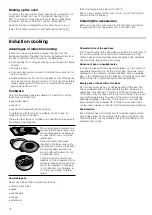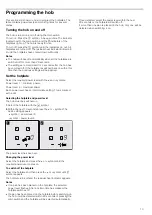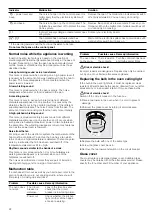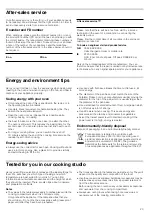
22
Normal noise while the appliance is working
Induction heating technology is based on the creation of
electromagnetic fields that generate heat directly at the base of
the pan. Depending on how the pan has been manufactured,
certain noises or vibrations may be produced such as those
described below:
A deep humming sound as in a transformer
This noise is produced when cooking on a high power level. It
is caused by the amount of energy transferred from the hob to
the pan. The noise disappears or becomes faint when the
power level is lowered.
A low whistling sound
This noise is produced when the pan is empty. The noise
disappears when water or food is added to the pan.
A crackling sound
This noise occurs in pans which are made from different
materials superimposed on one another. It is caused by the
vibrations that occur in the adjoining surfaces of the different
superimposed materials. The noise comes from the pan. The
amount of food and cooking method can vary noise intensity.
A high-pitched whistling sound
This noise is produced mainly in pans made from different
materials superimposed on one another, and it occurs when
such pans are heated at maximum power on two hotplates at
the same time. The whistling disappears or becomes fainter as
soon as the power level is lowered.
Noise from the fan
For proper use of the electronic system, the temperature of the
hob must be controlled. To do this, the hob has a fan which
turns on when a high temperature is detected. The fan may also
work by inertia after the hob has been switched off, if the
temperature detected is still too high.
Rhythmic sounds similar to the hands of a clock
This noise is only produced when 3 or more hotplates are
working and disappears or is reduced when one of the
hotplates is switched off.
The noises described are normal, they are part of induction
heating technology and not a sign of malfunction.
Malfunction table
If a dish doesn't turn out as well as you had hoped, refer to the
section
Tested for you in our cooking studio
, where you will
find plenty of cooking tips and tricks.
:
Risk of electric shock!
Incorrect repairs are dangerous. Repairs may only be carried
out by one of our trained after-sales engineers.
Replacing the bulb in the oven ceiling light
If the bulb in the oven light fails, it must be replaced. Heat-
resistant, 40 watt spare bulbs can be obtained from our after-
sales service or a specialist retailer. Only use these bulbs.
:
Risk of electric shock!
Switch off the circuit breaker in the fuse box.
1.
Place a tea towel in the oven when it is cold to prevent
damage.
2.
Unscrew the glass cover by turning it anti-clockwise.
3.
Replace the bulb with one of the same type.
4.
Screw the glass cover back in.
5.
Remove the tea towel and switch on the circuit breaker.
Glass cover
You must replace a damaged glass cover. Suitable glass
covers may be obtained from the after-sales service. Please
specify the E number and FD number of your appliance.
Ӡ
+ power level and
beep
There is a hot pan on the control panel. It is
highly likely that the electronic system will
overheat.
Remove that pan. The malfunction indicator will switch
off shortly afterwards. You can carry on cooking.
Ӡ
and beep
There is a hot pan on the control panel. The
hotplate has switched off to protect the elec-
tronic system.
Remove that pan. Wait a few seconds. Press any con-
trol panel. When the malfunction indicator switches off,
you can carry on cooking.
—‚
Incorrect supply voltage, outside normal oper-
ating limits.
Contact your electricity board.
—ƒ
/
—„
The hotplate has overheated and has
switched off in order to protect its hob.
Wait until the electronic system has cooled down suffi-
ciently before switching it back on.
Indicator
Malfunction
Solution
* If the warning persists call the Technical Assistance Service.
Do not rest hot pans on the control panel.
Problem
Possible cause Remedy/information
The oven does
not work.
The circuit
breaker is
defective.
Look in the fuse box and
check that the circuit
breaker is in working order.
Power cut
Check whether the kitchen
light or other kitchen appli-
ances are working.
The oven does
not heat up.
There is dust on
the contacts.
Turn the control knobs back
and forth several times.
Problem
Possible cause Remedy/information











































